Al2O3 Preforms Infiltrated with Poly(methyl methacrylate) for Dental Prosthesis Manufacturing
Abstract
:1. Introduction
2. Materials and Methods
2.1. Raw Materials
2.2. Preparation of the Al2O3 Preforms
2.3. Methyl Methacrylate Monomer-Infiltration
2.4. Characterizations and Physico-Mechanical Properties
3. Results and Discussion
3.1. Crystalline Phases, Chemical Analysis and Particle Size Distributions of the Al2O3 Commercial Powders
3.2. SEM Investigation and Physico-Mechanical Properties of the Poly(methyl methacrylate)-Infiltrated Al2O3 Samples
4. Conclusions
Author Contributions
Funding
Institutional Review Board Statement
Informed Consent Statement
Data Availability Statement
Conflicts of Interest
References
- Montazerian, M.; Zanotto, E.D. Bioactive and Inert Dental Glass-Ceramics. J. Biomed. Mater. Res. A 2017, 105, 619–639. [Google Scholar] [CrossRef] [PubMed]
- Sakaguchi, R.L.; Powers, J.M. Craig’s Restorative Dental Materials, 13th ed.; Elsevier, Mosby: Philadelphia, PA, USA, 2012; ISBN 978-0-323-08108-5. [Google Scholar]
- Schmalz, G.; Watts, D.C.; Darvell, B.W. Dental Materials Science: Research, Testing and Standards. Dent. Mater. 2021, 37, 379–381. [Google Scholar] [CrossRef] [PubMed]
- Ferracane, J.L. Current Trends in Dental Composites. Crit. Rev. Oral Biol. Med. 1995, 6, 302–318. [Google Scholar] [CrossRef] [PubMed] [Green Version]
- Wang, Y.; Zhu, M.; Zhu, X.X. Functional Fillers for Dental Resin Composites. Acta Biomater. 2021, 122, 50–65. [Google Scholar] [CrossRef] [PubMed]
- Lange, R.-T.; Pfeiffer, P. Clinical Evaluation of Ceramic Inlays Compared to Composite Restorations. Oper. Dent. 2009, 34, 263–272. [Google Scholar] [CrossRef] [PubMed] [Green Version]
- Vanoorbeek, S.; Vandamme, K.; Lijnen, I.; Naert, I. Computer-Aided Designed/Computer-Assisted Manufactured Composite Resin versus Ceramic Single-Tooth Restorations: A 3-Year Clinical Study. Int. J. Prosthodont. 2010, 23, 223–230. [Google Scholar] [PubMed]
- Gonzaga, C.C.; Yoshimura, H.N.; Cesar, P.F.; Miranda, W.G.J. Subcritical Crack Growth in Porcelains, Glass-Ceramics, and Glass-Infiltrated Alumina Composite for Dental Restorations. J. Mater. Sci. Mater. Med. 2009, 20, 1017–1024. [Google Scholar] [CrossRef] [PubMed]
- Coldea, A.; Swain, M.V.; Thiel, N. Mechanical Properties of Polymer-Infiltrated-Ceramic-Network Materials. Dent. Mater. 2013, 29, 419–426. [Google Scholar] [CrossRef]
- Zafar, M.S. Prosthodontic Applications of Polymethyl Methacrylate (PMMA): An Update. Polymers 2020, 12, 2299. [Google Scholar] [CrossRef]
- Abdulkareem, M.M.; Hatim, N.A. Evaluation the Biological Effect of Adding Aluminum Oxide, Silver Nanoparticles into Microwave Treated PMMA Powder. Int. J. Enhanc. Res. Sci. Technol. Eng. 2015, 4, 172–178. [Google Scholar]
- Chaijareenont, P.; Takahashi, H.; Nishiyama, N.; Arksornnukit, M. Effect of Different Amounts of 3-Methacryloxypropyltrimethoxysilane on the Flexural Properties and Wear Resistance of Alumina Reinforced PMMA. Dent. Mater. J. 2012, 31, 623–628. [Google Scholar] [CrossRef] [PubMed] [Green Version]
- Vojdani, M.; Bagheri, R.; Khaledi, A.A.R. Effects of Aluminum Oxide Addition on the Flexural Strength, Surface Hardness, and Roughness of Heat-Polymerized Acrylic Resin. J. Dent. Sci. 2012, 7, 238–244. [Google Scholar] [CrossRef] [Green Version]
- Kul, E.; Aladağ, L.İ.; Yesildal, R. Evaluation of Thermal Conductivity and Flexural Strength Properties of Poly(Methyl Methacrylate) Denture Base Material Reinforced with Different Fillers. J. Prosthet. Dent. 2016, 116, 803–810. [Google Scholar] [CrossRef] [PubMed]
- ISO 6872:2015—Dentistry—Ceramic Materials, 4th ed.; International Organization for Standardization: Geneva, Switzerland, 2015.
- de Oliveira, I.R.; Studart, A.R.; Pileggi, R.G.; Pandolfelli, V.C. Dispersão e Empacotamento de Partículas: Princípios e Aplicações em Processamento Cerâmico; Fazendo Arte Editorial: Sao Paolo, Brazil, 2000. [Google Scholar]
- Randall, M. German Particle Packing Characteristics; Metal Powder Industries Federation: Princeton, NJ, USA, 1999; ISBN 0918404835. [Google Scholar]
- Coldea, A.; Swain, M.V.; Thiel, N. Hertzian Contact Response and Damage Tolerance of Dental Ceramics. J. Mech. Behav. Biomed. Mater. 2014, 34, 124–133. [Google Scholar] [CrossRef] [PubMed]
- Patel, M.P.; Braden, M.; Davy, K.W.M. Polymerization Shrinkage of Methacrylate Esters. Biomaterials 1987, 8, 53–56. [Google Scholar] [CrossRef]
- Franco Steier, V.; Koplin, C.; Kailer, A. Influence of Pressure-Assisted Polymerization on the Microstructure and Strength of Polymer-Infiltrated Ceramics. J. Mater. Sci. 2013, 48, 3239–3247. [Google Scholar] [CrossRef]
- Albero, A.; Pascual, A.; Camps, I.; Grau-Benitez, M. Comparative Characterization of a Novel Cad-Cam Polymer-Infiltrated-Ceramic-Network. J. Clin. Exp. Dent. 2015, e495–e500. [Google Scholar] [CrossRef] [PubMed]
- Facenda, J.C.; Borba, M.; Corazza, P.H. A Literature Review on the New Polymer-Infiltrated Ceramic-Network Material (PICN). J. Esthet. Restor. Dent. 2018, 30, 281–286. [Google Scholar] [CrossRef] [PubMed]

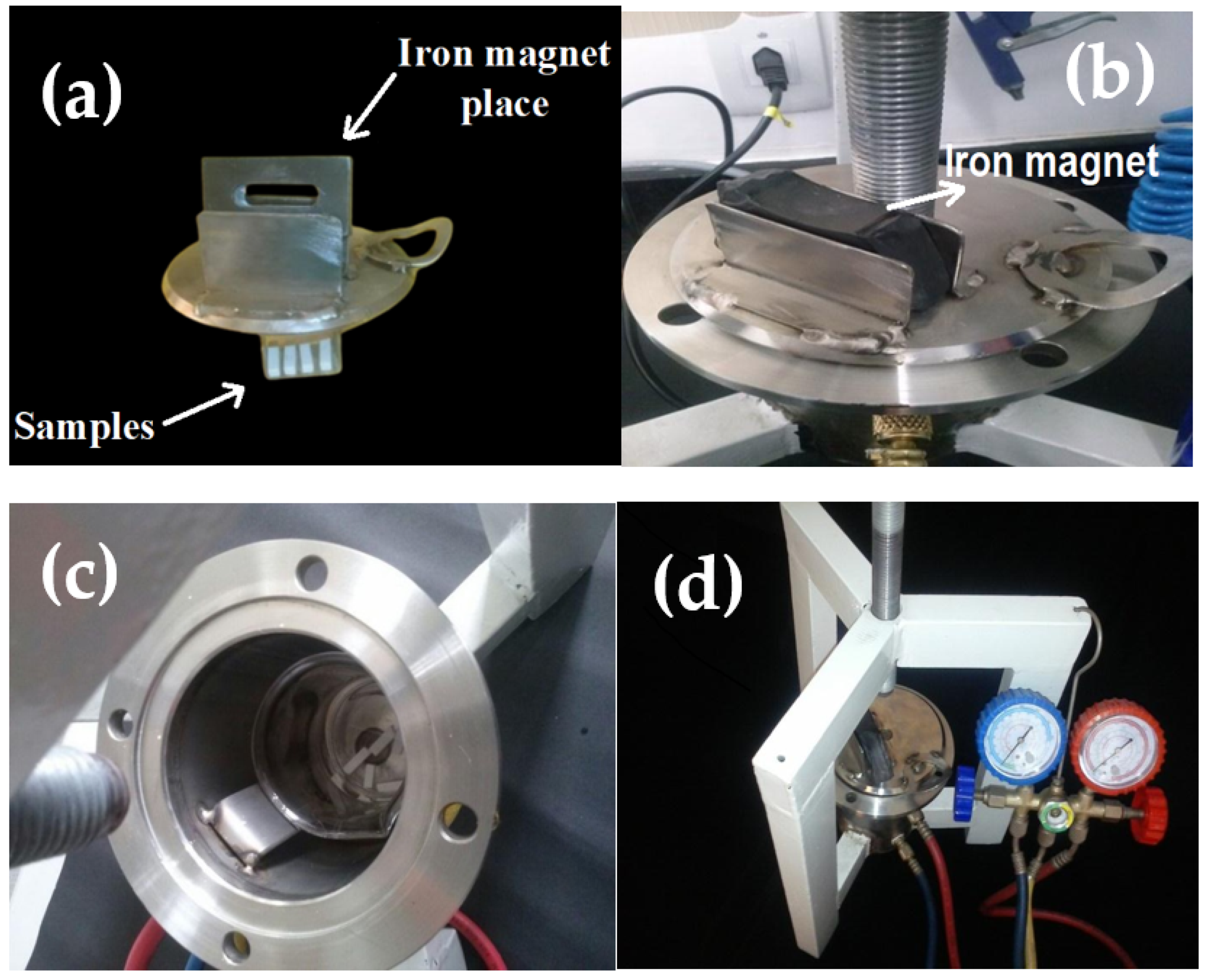
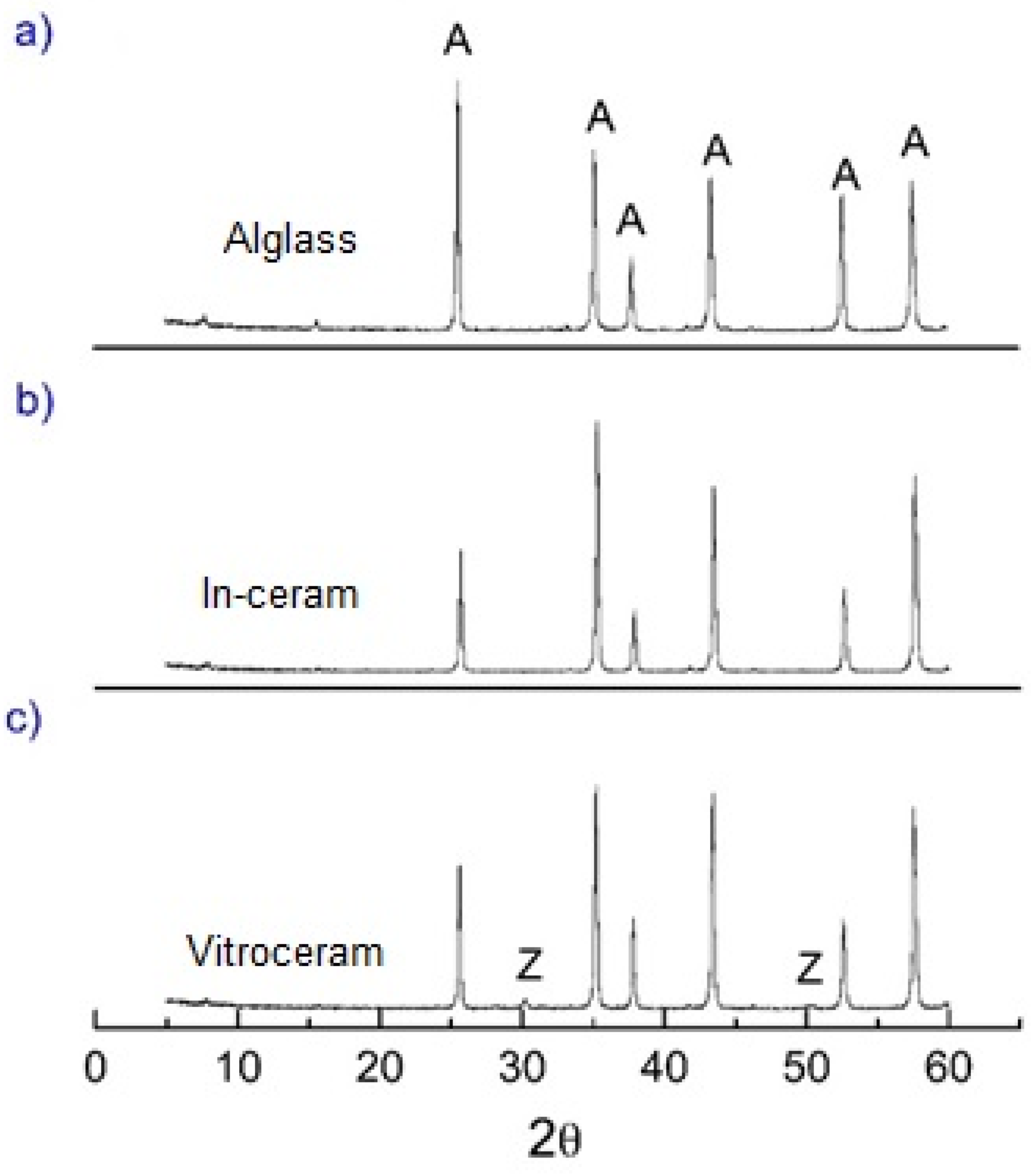
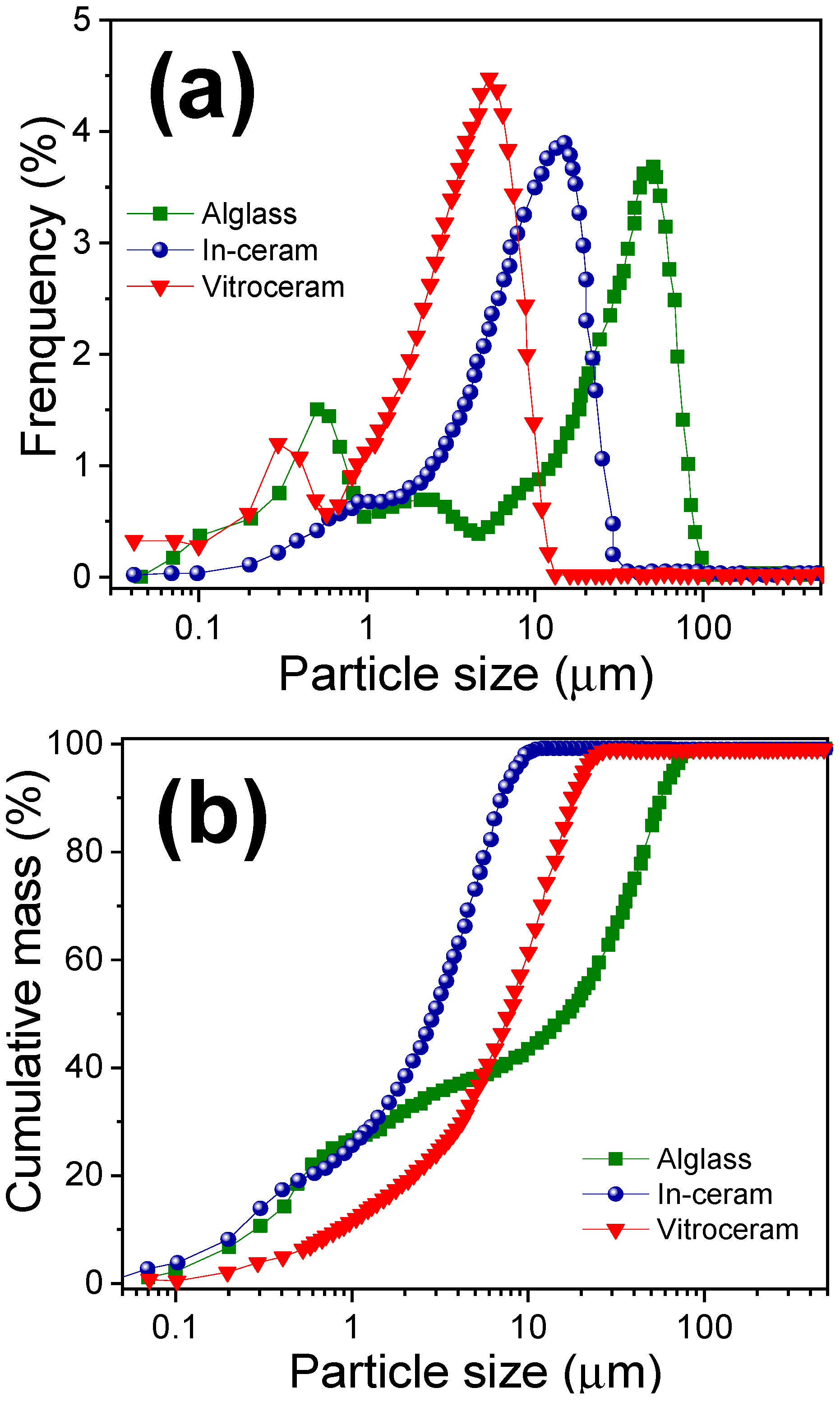
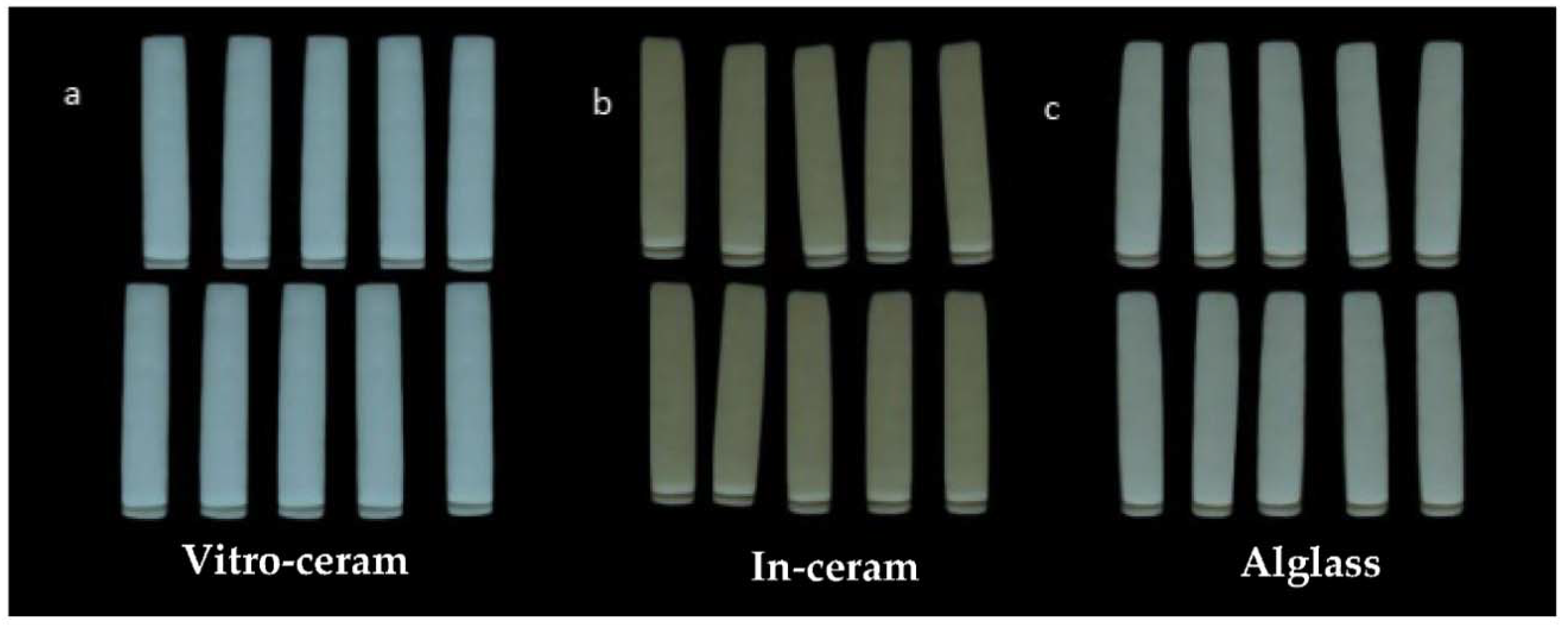
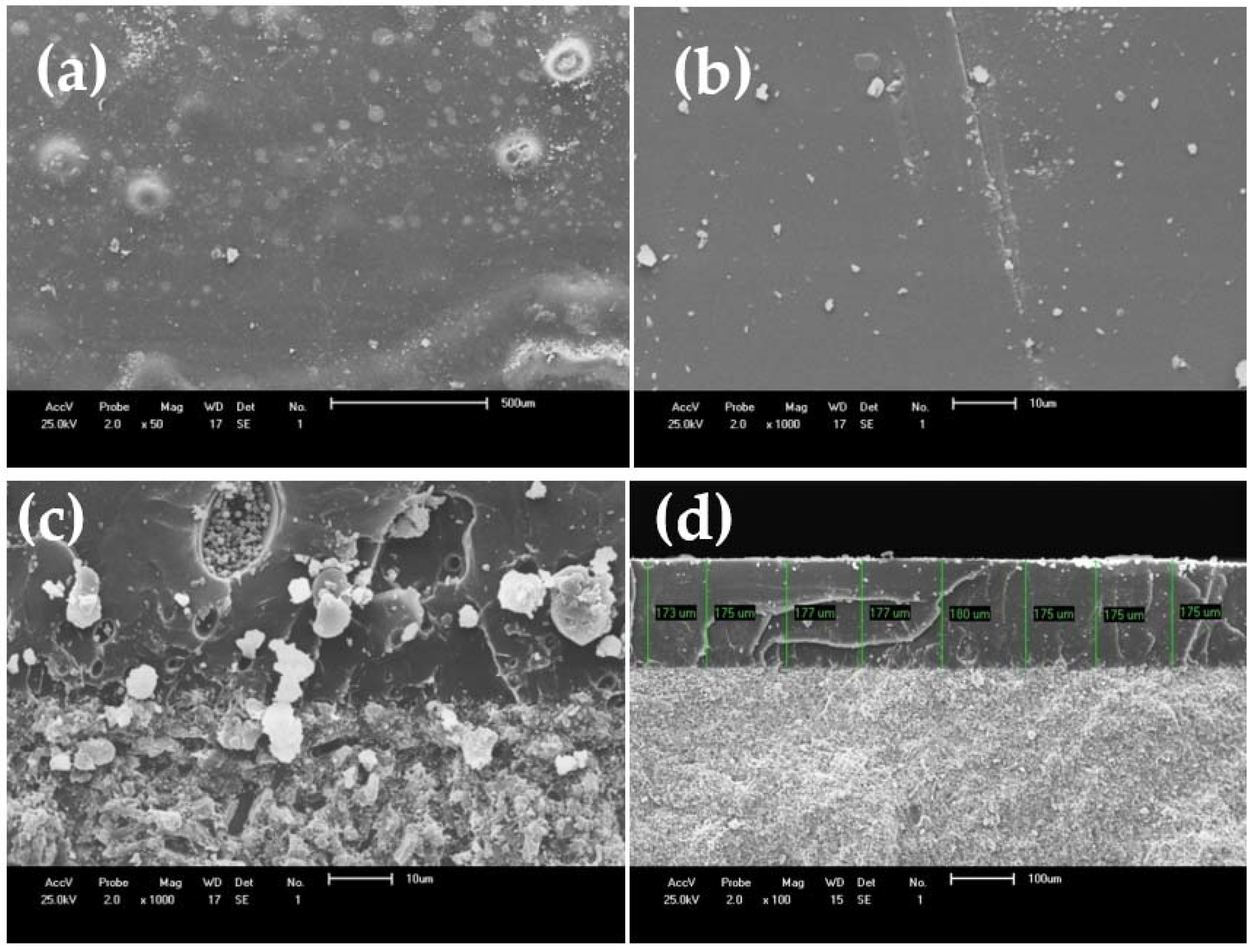
| Suppliers | Specimens Conditions | Time (h) | Estimated Amount of PMMA (vol.%) |
|---|---|---|---|
| Alglass | Without infiltration | 0 | 0 |
| In-ceram | Without infiltration | 0 | 0 |
| Vitro-ceram | Without infiltration | 0 | 0 |
| Alglass | With infiltration | 6 | 13 |
| In-ceram | With infiltration | 6 | 12 |
| Vitro-ceram | With infiltration | 6 | 9 |
| Alglass | With infiltration | 12 | 16 |
| In-ceram | With infiltration | 12 | 20 |
| Vitro-ceram | With infiltration | 12 | >9 |
| Samples | (wt.%) | ||||
|---|---|---|---|---|---|
| Al2O3 | SiO2 | P2O5 | ZrO2 | Other Oxides | |
| Alglass | 99.6 | 0.2 | – | – | 0.02 |
| In-ceram | 99.8 | – | – | – | 0.02 |
| Vitro-ceram | 98.9 | – | 0.5 | 0.3 | 0.30 |
| Ceramic Samples | Infiltration Time (h) | Density (g/cm3) | Porosity (%) | Water Absorption (%) |
|---|---|---|---|---|
| Alglass | 0 | 2.6 ± 0.03 | 29.4 ± 0.6 | 9.9 ± 0.2 |
| 6 | 2.8 ± 0.04 | 16.1 ± 3.9 | 5.4 ± 1.3 | |
| 12 | 2.8 ± 0.04 | 13.4 ± 2.6 | 4.5 ± 0.8 | |
| In-ceram | 0 | 2.6 ± 0.08 | 33.1 ± 2.2 | 11.1 ± 1.0 |
| 6 | 2.6 ± 0.23 | 21.0 ± 11.7 | 7.3 ± 4.3 | |
| 12 | 2.8 ± 0.06 | 13.6 ± 11.6 | 4.5 ± 3.8 | |
| Vitro-ceram | 0 | 2.7 ± 0.01 | 28.1 ± 2.8 | 9.0 ± 0.09 |
| 6 | 2.7 ± 0.34 | 18.8 ± 5.5 | 6.9 ± 1.6 | |
| 12 | 2.8 ± 0.07 | 0.2 ± 0.1 | 0.14 ± 0.07 |
| Ceramic Samples | Infiltration Time (h) | Average of Density (g/cm3) | Average of Porosity (%) | Average of Water Absorption (%) |
|---|---|---|---|---|
| Alglass | 0 | 2.6 b | 29.4 a | 9.9 a |
| 6 | 2.8 a | 16.1 b | 5.4 b | |
| 12 | 2.8 a | 13.4 b | 4.5 b | |
| p = 0.002 | p < 0.001 | p < 0.0001 | ||
| In-ceram | 0 | 2.6 a | 33.1 a | 11.1 a |
| 6 | 2.6 a | 21.0 b | 7.3 ab | |
| 12 | 2.8 a | 13.6 b | 4.5 b | |
| p = 0.04 | p < 0.001 | p = 0.0023 | ||
| Vitro-ceram | 0 | 2.8 a | 28.1 a | 9.0 a |
| 6 | 2.5 a | 18.8 b | 6.9 b | |
| 12 | 2.6 a | 0.2 c | 0.1 c | |
| p = 0.68 | p < 0.001 | p < 0.0001 |
| Ceramic Samples | Infiltration Time (h) | Flexural Strength (MPa) | Microhardness (HV) |
|---|---|---|---|
| Alglass | 0 | 9.0 ± 2.1 | 455.0 ± 36.6 |
| 6 | 9.4 ± 5.1 | 468.8 ± 15.5 | |
| 12 | 16.5 ± 5.4 | 519.1 ± 39.5 | |
| In-ceram | 0 | 41.0 ± 3.8 | 458.0 ± 28.2 |
| 6 | 61.0 ± 7.7 | 704.0 ± 41.7 | |
| 12 | 75.9 ± 8.0 | 857.0 ± 55.1 | |
| Vitro-ceram | 0 | 37.5 ± 17.6 | 439.0 ± 37.3 |
| 6 | 78.8 ± 16.6 | 1030.7 ± 52.3 | |
| 12 | 119.3 ± 23.6 | 1055.1 ± 111.0 | |
| PMMA | – | 25.0 ± 5.0 | 216.0 ± 41.7 |
| Ceramic Samples | Infiltration Time (h) | Average of Flexural Strength (MPa) | Average of Microhardness (HV) |
|---|---|---|---|
| Alglass | 0 | 9.0 a | 455.7 b |
| 6 | 9.4 a | 468.8 b | |
| 12 | 16.5 a | 519.1 a | |
| p = 0.0737 | p = 0.0003 | ||
| In-ceram | 0 | 41.0 c | 458.0 c |
| 6 | 61.0 b | 704.9 b | |
| 12 | 75.9 a | 857.5 a | |
| p < 0.0001 | p < 0.0001 | ||
| Vitro-ceram | 0 | 37.5 c | 439.8 b |
| 6 | 78.8 b | 1030.7 a | |
| 12 | 119.3 a | 1055.1 a | |
| p < 0.0001 | p < 0.0001 |
Publisher’s Note: MDPI stays neutral with regard to jurisdictional claims in published maps and institutional affiliations. |
© 2021 by the authors. Licensee MDPI, Basel, Switzerland. This article is an open access article distributed under the terms and conditions of the Creative Commons Attribution (CC BY) license (https://creativecommons.org/licenses/by/4.0/).
Share and Cite
Crispim da Silveira, O.; Rodrigues, A.M.; Montazerian, M.; de Lucena Lira, H.; Baino, F.; Menezes, R.R. Al2O3 Preforms Infiltrated with Poly(methyl methacrylate) for Dental Prosthesis Manufacturing. Appl. Sci. 2021, 11, 7583. https://doi.org/10.3390/app11167583
Crispim da Silveira O, Rodrigues AM, Montazerian M, de Lucena Lira H, Baino F, Menezes RR. Al2O3 Preforms Infiltrated with Poly(methyl methacrylate) for Dental Prosthesis Manufacturing. Applied Sciences. 2021; 11(16):7583. https://doi.org/10.3390/app11167583
Chicago/Turabian StyleCrispim da Silveira, Olimpia, Alisson Mendes Rodrigues, Maziar Montazerian, Hélio de Lucena Lira, Francesco Baino, and Romualdo Rodrigues Menezes. 2021. "Al2O3 Preforms Infiltrated with Poly(methyl methacrylate) for Dental Prosthesis Manufacturing" Applied Sciences 11, no. 16: 7583. https://doi.org/10.3390/app11167583
APA StyleCrispim da Silveira, O., Rodrigues, A. M., Montazerian, M., de Lucena Lira, H., Baino, F., & Menezes, R. R. (2021). Al2O3 Preforms Infiltrated with Poly(methyl methacrylate) for Dental Prosthesis Manufacturing. Applied Sciences, 11(16), 7583. https://doi.org/10.3390/app11167583











